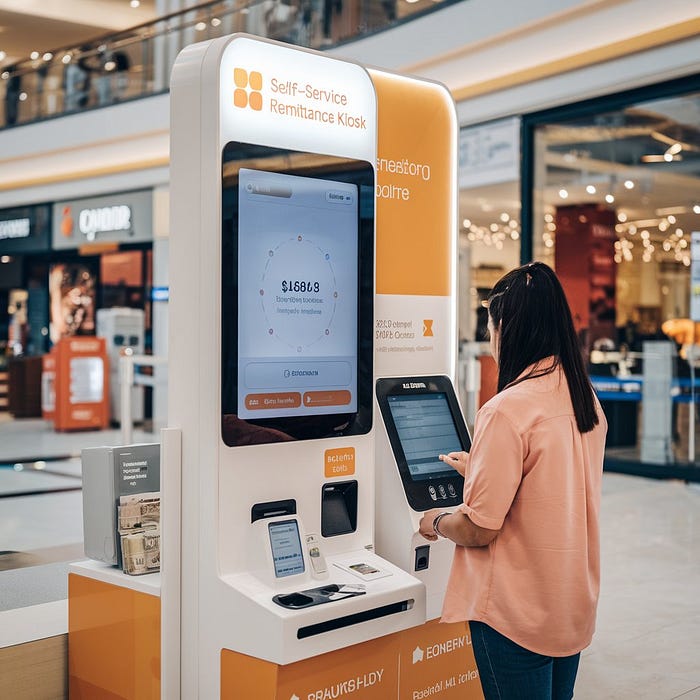What is a self service remittance kiosk? Is it right for you?

In today’s fast-paced financial landscape, efficiency and convenience have become top priorities for individuals and businesses alike. One sector that has significantly evolved to accommodate these needs is remittance services. With millions of people sending money across borders regularly, the demand for seamless, secure, and cost-effective solutions has surged. Self-service remittance kiosks have emerged as a game-changing innovation, providing users with the ability to transfer money quickly and easily without the need for human intervention. But what exactly are these kiosks, and how do they work? This blog explores the concept of self-service remittance kiosks, their features, benefits, and important considerations before using them.
Understanding Self-Service Remittance Kiosks
What Are Self-Service Remittance Kiosks?
Self-service remittance kiosks are automated machines designed to facilitate money transfers without requiring assistance from a human teller. These kiosks function similarly to ATMs but are specifically tailored for remittance transactions. Users can deposit money into the kiosk, select their desired transfer method, and complete transactions within minutes.
These kiosks are typically placed in high-traffic locations such as shopping malls, transport hubs, and convenience stores, making them easily accessible to a broad demographic. With multilingual support and user-friendly interfaces, they cater to both tech-savvy individuals and those who may not be as comfortable with digital transactions.
Features of Self-Service Remittance Kiosks
- User-Friendly Interface: The kiosks feature intuitive touchscreens, allowing users to navigate the remittance process effortlessly. Many kiosks also offer language options to accommodate non-native speakers.
- Multiple Currency Options: Users can send money in various currencies, depending on the recipient’s country. Exchange rates are usually displayed on the screen, helping users make informed decisions.
- Transaction Speed: Unlike traditional remittance services that may require waiting in long lines, self-service kiosks enable near-instant money transfers.
- Multiple Payment Methods: Some kiosks accept cash, debit/credit cards, and even mobile wallet payments.
- Secure Transactions: Advanced security measures, such as biometric verification, PIN authentication, and encryption technology, ensure that transactions remain safe from fraud.
- 24/7 Availability: Unlike traditional money transfer outlets with restricted hours, self-service kiosks operate around the clock, providing users with greater flexibility.
Operation Process of Kiosks
- User Identification: The user begins by verifying their identity using a government-issued ID, mobile number, or biometric authentication.
- Selecting Transfer Details: The user selects the recipient’s country, currency, and preferred transfer method (bank deposit, cash pickup, or mobile wallet).
- Entering Recipient Information: The user inputs the recipient’s name, phone number, and bank details if applicable.
- Payment Processing: The user inserts cash or uses a card/mobile wallet to fund the transaction.
- Transaction Confirmation: The kiosk processes the transaction and generates a receipt containing a tracking number for reference.
- Completion and Notification: The recipient is notified via SMS or email once the transfer is completed.
Benefits of Using Self-Service Remittance Kiosks

Convenience and Accessibility
One of the biggest advantages of self-service remittance kiosks is their accessibility. Unlike traditional remittance services that require visiting a bank or a money transfer outlet, kiosks are available 24/7 in easily accessible locations. This is particularly beneficial for:
- Individuals working odd hours who cannot visit traditional outlets.
- Migrant workers needing an immediate transfer option for their families.
- People in remote areas with limited access to financial institutions.
Cost Benefits Compared to Traditional Methods
Self-service remittance kiosks often provide lower transaction fees compared to banks and traditional money transfer agencies. Since these kiosks operate with minimal human intervention, operational costs are reduced, allowing service providers to pass on the savings to customers. Additionally, competitive exchange rates ensure users get better value for their money.
Other cost benefits include:
- Elimination of agent commissions.
- Reduced dependency on intermediaries, which can lead to hidden charges.
- Faster processing, which can minimize additional service fees for urgent transfers.
Considerations Before Using a Self-Service Remittance Kiosk
User Experience and Technical Support
While self-service kiosks are designed for ease of use, some users may encounter technical issues or have difficulty navigating the process. Therefore, it is essential to consider the following:
- Multilingual Support: Ensure the kiosk offers instructions in a language you understand.
- Customer Assistance: Some kiosks provide a helpline or live chat support for troubleshooting.
- Transaction Limits: Be aware of any maximum or minimum transfer limits imposed by the service provider.
- Receipt and Tracking: Always collect a receipt and ensure there is a way to track your transaction status online or via SMS.
Security Concerns with Kiosks
As with any financial transaction, security is a critical consideration when using self-service remittance kiosks. Potential risks include fraud, data breaches, and transaction errors. To mitigate these risks:
- Use Trusted Kiosks: Only transact at reputable kiosks operated by well-known financial institutions or service providers.
- Enable Two-Factor Authentication: If the service provider offers additional authentication, enable it to protect your transaction.
- Be Cautious of Surroundings: Avoid using kiosks in poorly lit or isolated areas to reduce the risk of theft or fraud.
- Check for Skimming Devices: Inspect the card reader for any suspicious attachments before inserting your card.
Conclusion: Is a Self-Service Remittance Kiosk Right for You?
Self-service remittance kiosks provide a modern, efficient, and cost-effective alternative to traditional money transfer methods. Their user-friendly interfaces, 24/7 availability, and competitive pricing make them an attractive option for individuals seeking quick and secure transactions.
However, before using a kiosk, it is important to consider your specific needs and circumstances. If you value convenience, affordability, and speed, self-service remittance kiosks can be an excellent choice. On the other hand, if you require personalized assistance or have concerns about security, traditional remittance services might still be preferable.
Ultimately, self-service remittance kiosks are transforming the way people send money globally, making financial transactions more accessible and efficient. As technology continues to evolve, these kiosks will likely become even more sophisticated, further enhancing the remittance experience for users worldwide.
Comments
Post a Comment